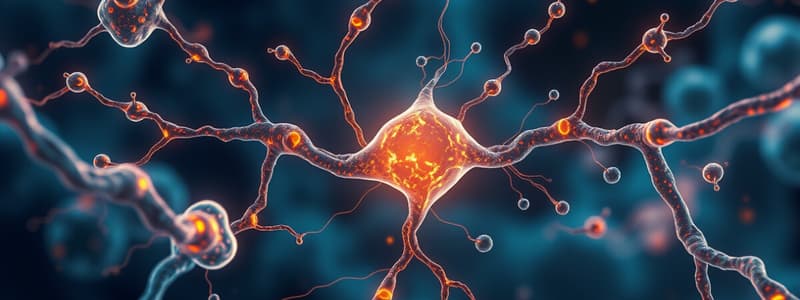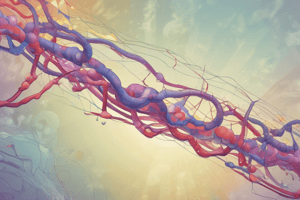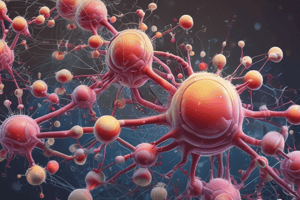Podcast
Questions and Answers
What are the products of the cyclooxygenase pathway?
What are the products of the cyclooxygenase pathway?
- Epoxides
- Prostaglandins and thromboxane (correct)
- HETE
- Leukotrienes
Which of the following functions is NOT attributed to eicosanoids?
Which of the following functions is NOT attributed to eicosanoids?
- Regulation of blood pressure
- Formation of blood clots
- Vision regulation (correct)
- Smooth muscle contraction
At what concentrations do eicosanoids typically exert their effects?
At what concentrations do eicosanoids typically exert their effects?
- Moderate concentrations
- Very low concentrations (correct)
- Very high concentrations
- Constant levels
Which component is found in the structure of thromboxanes?
Which component is found in the structure of thromboxanes?
Which receptor type is primarily mediated by eicosanoids?
Which receptor type is primarily mediated by eicosanoids?
Which of the following is NOT a product of the lipoxygenase pathway?
Which of the following is NOT a product of the lipoxygenase pathway?
Which physiological function is directly linked to eicosanoids?
Which physiological function is directly linked to eicosanoids?
What characteristic is essential for the structure of prostaglandins?
What characteristic is essential for the structure of prostaglandins?
Which eicosanoid is known to affect blood flow to specific organs?
Which eicosanoid is known to affect blood flow to specific organs?
What is the primary role of arachidonic acid in cellular biochemistry?
What is the primary role of arachidonic acid in cellular biochemistry?
Which enzyme is primarily responsible for the release of free arachidonic acid from membrane phospholipids?
Which enzyme is primarily responsible for the release of free arachidonic acid from membrane phospholipids?
Which type of cells can be stimulated by thrombin to release arachidonic acid?
Which type of cells can be stimulated by thrombin to release arachidonic acid?
What determines the rate of product formation in relation to arachidonic acid release?
What determines the rate of product formation in relation to arachidonic acid release?
In which position on the glycerol backbone is arachidonic acid stored in cell membrane phospholipids?
In which position on the glycerol backbone is arachidonic acid stored in cell membrane phospholipids?
What is released from phosphatidylinositol by the action of phospholipase C?
What is released from phosphatidylinositol by the action of phospholipase C?
What is the effect of bradykinin on renal tubular cells regarding arachidonic acid?
What is the effect of bradykinin on renal tubular cells regarding arachidonic acid?
What is the function of leukotrienes derived from arachidonic acid?
What is the function of leukotrienes derived from arachidonic acid?
The hydrolysis of arachidonate is primarily facilitated by which enzyme?
The hydrolysis of arachidonate is primarily facilitated by which enzyme?
Which of the following is NOT produced from arachidonic acid?
Which of the following is NOT produced from arachidonic acid?
What is the role of hydroxyl fatty acid derivatives in eicosanoid metabolism?
What is the role of hydroxyl fatty acid derivatives in eicosanoid metabolism?
Which eicosanoid formation is primarily affected by NSAIDs?
Which eicosanoid formation is primarily affected by NSAIDs?
Which of the following NSAIDs is NOT mentioned as an example?
Which of the following NSAIDs is NOT mentioned as an example?
What does the subscript in nomenclature denote?
What does the subscript in nomenclature denote?
Which substitution positions are identified for hydroperoxy in nomenclature?
Which substitution positions are identified for hydroperoxy in nomenclature?
What condition may NSAIDs potentially trigger due to increased leukotrienes?
What condition may NSAIDs potentially trigger due to increased leukotrienes?
Which of the following best describes the structure of hydroperoxy-eicosatetraenoic acid?
Which of the following best describes the structure of hydroperoxy-eicosatetraenoic acid?
What effect do NSAIDs have on blood clot formation?
What effect do NSAIDs have on blood clot formation?
What type of acid is hydroperoxy-eicosatetraenoic acid derived from?
What type of acid is hydroperoxy-eicosatetraenoic acid derived from?
What is the effect of thromboxane A2 produced by COX-1 in activated platelets?
What is the effect of thromboxane A2 produced by COX-1 in activated platelets?
What is a primary function of eicosanoids?
What is a primary function of eicosanoids?
How does prostacyclin (PGI2) influence platelet activity?
How does prostacyclin (PGI2) influence platelet activity?
Which of the following is a primary effect of low-dose aspirin therapy?
Which of the following is a primary effect of low-dose aspirin therapy?
What is the primary mechanism of action of aspirin in relation to prostaglandins?
What is the primary mechanism of action of aspirin in relation to prostaglandins?
What effect does cortisol have on phospholipase A2?
What effect does cortisol have on phospholipase A2?
Which statement best describes the impact of NSAIDs like aspirin and indomethacin?
Which statement best describes the impact of NSAIDs like aspirin and indomethacin?
What is the primary biological role of COX-1 in the body?
What is the primary biological role of COX-1 in the body?
Which of the following correctly describes the effect of ibuprofen on PGH synthase?
Which of the following correctly describes the effect of ibuprofen on PGH synthase?
Why is acetaminophen considered to have weak anti-inflammatory effects?
Why is acetaminophen considered to have weak anti-inflammatory effects?
What is a primary function of leukotrienes in the body?
What is a primary function of leukotrienes in the body?
What is the role of 5-lipoxygenase in the lipooxygenase system?
What is the role of 5-lipoxygenase in the lipooxygenase system?
Which class of drugs is referred to as selective COX-2 inhibitors?
Which class of drugs is referred to as selective COX-2 inhibitors?
How does PGH synthase contribute to the synthesis of PGH2?
How does PGH synthase contribute to the synthesis of PGH2?
What is one major consequence of elevated PG synthesis mediated by COX-2?
What is one major consequence of elevated PG synthesis mediated by COX-2?
What effect does high concentrations of peroxides have on acetaminophen's efficacy?
What effect does high concentrations of peroxides have on acetaminophen's efficacy?
What essential fatty acid is a precursor to prostaglandins and other related substances?
What essential fatty acid is a precursor to prostaglandins and other related substances?
Flashcards are hidden until you start studying
Study Notes
Eicosanoids Function
- Derived from arachidonic acid, a 20-carbon polyunsaturated fatty acid.
- Not stored but synthesized on demand, responding to cellular signaling.
- Mediated by G-protein coupled receptors, influencing various physiological functions.
Functions of Eicosanoids
- Reproductive functions including smooth muscle contraction during menstruation and labor.
- Modulation of inflammation, resulting in fever and pain responses.
- Involvement in blood clot formation and regulation of blood flow to specific organs.
- Influence on wake-sleep cycles and responsiveness to hormones like epinephrine and glucagon.
- Regulation of gastric acid secretion and blood pressure.
Pathways for Eicosanoid Synthesis
- Cyclooxygenase Pathway: Produces prostaglandins and thromboxanes.
- Lipoxygenase Pathway: Generates leukotrienes, HETE (Hydroxyeicosatetraenoic acid), and lipoxins.
- Cytochrome P450 System: Synthesizes epoxides, HETE, and diHETE.
Prostaglandins
- Composed of a 20-carbon fatty acid structure with a 5-membered internal carbon ring and a hydroxyl group at carbon 15.
- Nomenclature begins with "PG" followed by capital letters indicating specific substitutions.
Thromboxanes
- Feature a 6-membered ring including an oxygen atom.
- Nomenclature uses "TX" with capital letters for ring substitutions and subscripts indicating unsaturated bonds.
- Function primarily in blood clot formation and reduction of blood flow to injury sites.
Hydroperoxy-eicosatetraenoic Acid (HETE)
- Hydroxyl fatty acid derivative of arachidonic acid, lacking a ring structure.
- Nomenclature includes hydroperoxy substitutions at positions 5, 12, and 15.
Metabolism of Eicosanoids
- Arachidonic acid is a precursor for major eicosanoids, stored as phospholipid esters in cell membranes.
- Released by phospholipase A2 when stimulated, influencing the rate of eicosanoid synthesis.
- Specific agonists like thrombin and bradykinin stimulate arachidonic acid production.
Synthesis of Eicosanoids
- Linoleic acid, an omega-6 fatty acid, is essential for prostaglandin production.
- Arachidonic acid is derived from dietary intake of linoleic acid.
- Prostaglandin H2 (PGH2) synthesized through oxidative cyclization of arachidonic acid, requiring oxygen and reducing agents.
Inhibition of Eicosanoid Synthesis
- Nonsteroidal anti-inflammatory drugs (NSAIDs) including aspirin, ibuprofen inhibit cyclooxygenase (COX) enzymes, shifting production to lipoxygenase pathways.
- NSAIDs can potentially induce asthma attacks through increased leukotriene synthesis.
Roles of Prostaglandins in Platelet Homeostasis
- Thromboxane A2 (TXA2): Promotes platelet aggregation and vasoconstriction; synthesized by COX-1 in activated platelets.
- Prostacyclin (PGI2): Inhibits platelet aggregation and promotes vasodilation; produced by COX-2 in vascular endothelium.
Aspirin and Its Effects
- Provides antithrombogenic effects by irreversibly acetylating COX enzymes, reducing TXA2 synthesis in platelets while affecting PGI2 synthesis in endothelial cells.
- Low-dose aspirin therapy lowers the risk of stroke and heart attacks by decreasing thrombus formation.
Studying That Suits You
Use AI to generate personalized quizzes and flashcards to suit your learning preferences.




